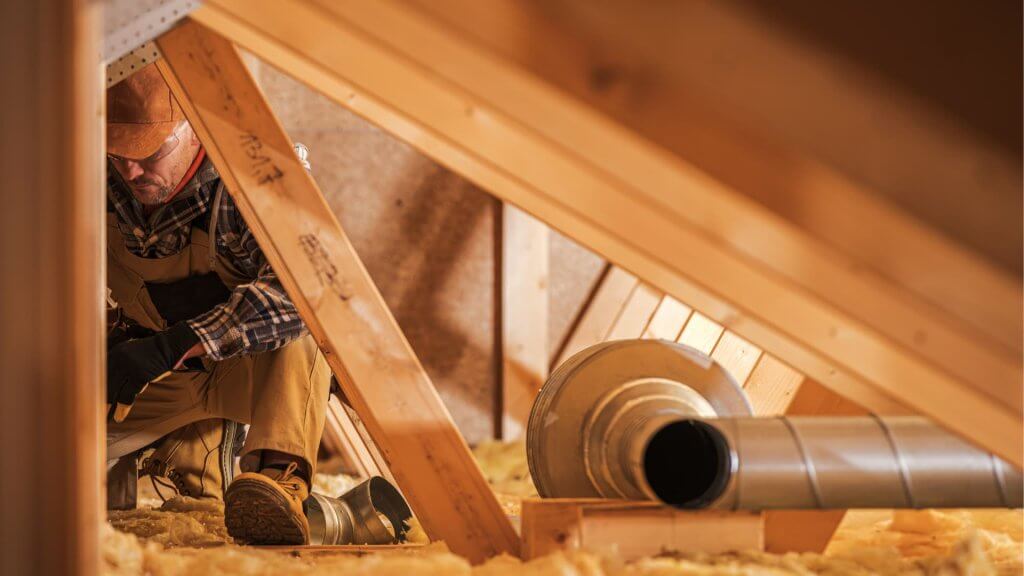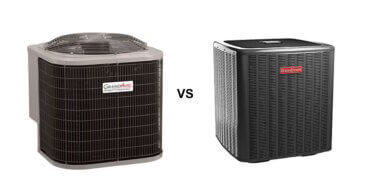How many times have you opened your attic latch to face a gush of hot air attacking you? It’s not surprising because the temperatures in unventilated attics can reach as much as 150°F in hot summers. Instead of tolerating this, check out these ways to get heat out of the attic and reduce your power bills.
How Do I Get Heat Out Of My Attic?
The attic is the last room in your home and the last stop for your home’s hot air. As the attic rests just under your roof, the heat also radiates through your shingles on hot summer days. The heat ends up in the attic, creating hot air.
There are two options to remove the heat in your attic: a passive and an active approach.
Passive ventilation
Installing additional vents and exhausts in the attic and roof is called the passive approach. It helps circulate and expel hot air from the attic naturally. There’s no harm in it, and it is cheaper than investing in a fan.
Also read: Is It OK to Cover a Heating Vent?
Active ventilation
The active approach includes installing an attic fan to exhaust hot air once it reaches a fixed temperature. You, of course, also need vents in the attic to accommodate this extra airflow.
Pushing stuffy air outside to let cooler and fresher air enter the attic improves its ventilation and lowers the temperature. You can save even more by installing a solar attic fan instead of an electrically powered one.

5 Best Ways To Get Heat Out Of The Attic
1. Start Sealing
Start by sealing the spaces around the vents, plumbing, and recessed lights. It helps prevent the hot air from seeping into your living space. You can end up saving as much as 10% in power bills just by doing this.
2. Adequate Insulation
Check to ensure you have enough attic insulation. There are so many types of attic insulation available, with different heat-blocking values.
Proper insulation helps keep your attic cool. It prevents hot air from entering and keeps heat out of the house. Some types of insulation, like reflective insulation, are exceptionally great at keeping heat out of your home. It reflects the incoming sunbeams. You can install it on your attic walls and ceiling.
Adequate insullation also prevents moisture entering and staying in the attic, creating the perfect environment for mold formation.
Different Types Of Insulation
There are different types of insulation like thermal, batt insulation, or spray polyurethane foam insulation.
Before you decide on the type of insulation material to insulate your roof, it is necessary that you compare the insulation values of the different materials. You have to check out the R-value of the material.
Good insulation has an R-value of 4 or more. To achieve an R-value of 4, you need a thickness of 5 inches for most insulation materials.
Natural materials often have a slightly lower insulation value, so you need a little more thickness to achieve the same result.
Rigid foam boards have a very high insulation value, so you need less thickness.
Next, identify where air escapes preventing unwanted heat from entering the attic. Don’t just plug leaky areas with caulk. Also, seal plumbing pipes and small wire openings with small pieces of fiberglass.
3. Install Proper Ventilation
First of all, there is no ‘best’ or ‘worst’ ventilation method. The best attic ventilation should be something providing adequate and balanced airflow. It allows an equal amount of air to both enter and exit the attic.
The ideal ventilation system depends on the climate, the building style of your home, and the shape of your roof. The technique that works in one region may not apply to another area.
Similarly, the technique which works for one home may not apply to another one. The number of vents required to bring in and expel air from the attic depends on the attic square footage and volume.
You can determine how many vents you need by taking your attic square feet and dividing it by 150. This equals 1 square feet of ventilation for every 150 square feet of attic space.
- Ridge or box vents are perfect for air exhaust and are placed in the ridge of the roof to let heat escape the attic.
- Soffit or fascia vents are ideal as intake vents, installed at a lower spot to draw in cool air and force hot air through the ridge vents (as hot air rises).
- And instead of vertical ventilation, horizontal or cross-ventilation are better options.
Gable vents help release the hot air in your attic to reduce the temperature. You can do it yourself if you are a DIY person by picking up the parts at a home improvement store. Or you can have a professional install them for you.
Unfortunately, many homeowners don’t even know their home has intake vents. They thus don’t clean them periodically, and the vents end up covered. So there’s no way for these vents to push hot air up or let cool air inside.
4. Install An Attic Fan
Attic fans help blow out the hot air to cool down the attic. A fan will also help prevent mold formation by circulating the air.
The first option is to install an electric attic fan. They come with thermostats that can be set to turn on only when the attic reaches a specific temperature.
You have two types of attic fans to use:
- Roof-mounted fans are installed on the roof. Therefore it’s generally better to leave it to a professional.
- Wall-mounted fans easily fit onto the wall without having to make significant changes.
Other Ways To Get Heat Out Of The Attic
Beside the above mentioned tips, there are some more ways to cool down a hot attic in summer.
5. Install An Additional Air Conditioner
You could add another air conditioner if your attic is an extra living space you and your family spend time in. If you use central air conditioning, discuss how to extend cool air to the attic with your AC technician.
Related articles:
What Are The Types of Air Conditioners?
Air Conditioners Buyer’s Guide
Should You Purchase a Portable or Window AC Unit?
5 Quietest Portable Air Conditioners
Whichever option you choose, make sure your attic is adequately insulated. Otherwise, you’ll end up wasting money.
Why Is My Finished Attic So Hot?
Your attic is most likely so hot because of poor ventilation. So check the exhaust vents, they should be the right size for your attic, where the larger lofts need larger vents.
Also, check out your ridge and soffit vents. These vents are usually covered with metal screens, but dirt or leaves may have cluttered them preventing airflow. Or perhaps they are too small to ventilate your attic. Consider installing gable vents and/or more ridge and soffit vents.
A third aspect is to check if your attic walls and roof are well insulated. Perhaps your insulation is worn and torn and needs replacement.
And last but not least, check if your fan still properly functions.
How Do You Tell If Your Attic Is Properly Ventilated?
There are a few ways to find out how well you’ve insulated your attic.
1. Monitoring Utility Bills
A climb in your electricity bills during summer and winter time may be a sign that you have ventilation problems. It indicates that your HVAC system is working overtime in keeping your home cool and warm in different seasons.
The attic heat transfers to your other living spaces, making them hotter. Therefore your HVAC system ends up working overtime, leading to higher utility bills.
Proper ventilation circulates hot air out, letting your cooling system work more efficiently.
2. Taking A Look At Your Roofs Condition
Leakages and warping of (parts of) your roof may indicate a ventilation problem. The moisture trapped in the attic also leads to ice dams forming in winter and mold and mildew in summer.
A bad condition of your roof can lead to premature rotting of framing elements. The hot sun also heats the attic, leading to hot and decomposed asphalt shingles. Proper ventilation helps ensure the quick escape of moisture.
3. Unwanted Critters
Did you know that poor ventilation can increase the number of pests in and around your home? It’s because the moisture in the attic creates the perfect warm and damp environment for them. Proper ventilation can prevent this from occurring.
4. Ice Dams
The warm attic air leads to snow on the roof melting and refreezing at the elves in winter. It, in turn, leads to the formation of ice dams.
In short, a well-ventilated attic extends the life of your HVAC system and roof. It also helps maintain good indoor air quality by expelling humid and stuffy air outdoors.
Is A Hot Attic Dangerous?
Yes, a hot attic makes it dangerous for your home’s electrical wiring to keep functioning properly.
It’s not the copper conductors that are affected by the heat. Copper conductors can sustain much higher temperatures.
The heat affects the plastic insulation and jacketing around the wires. Though they can withstand a maximum temperature of 194°F, preventing your attic from heating up is better.
And it’s not just the heat in the attic that heats the wire. The electric current flowing through the wires heats them even more. They get even hotter if they’re packed in tight bundles.
Wires that are so hot that you cannot touch them anymore are dangerous, they can overload your electric system.
How Can I Vent My Attic Without Soffits?
Some homes have minimal or non-existent overhangs, making it challenging to install soffit vents.
Don’t worry. There are some other options to bring in air from the roof perimeter. The most common options are:
- Installing low gable vents at the top level of your attic. You can also use ridge vents, mushroom cap vents, and upper gable vents.
- Installing a drip edge vent. It lets air enter under the shingles and reach the attic through a small 8” slot from the edge.
- Using eye-brow vents on the sloping roof area near the soffit area.
A professional can better decide on the best option that completely seals your attic to offer maximum insulation.
Conclusion
So the best ways to get heat out of the attic are through proper ventilation, proper insulation, and installation of fans. Do not neglect the heat in an attic. If left unattended, it can end up harming the roof structure and wiring system.
Related articles:
How To Keep Upstairs Cool In Summertime
How To Cool A Room With No Windows





Leave a Comment